Itinerary
A city of the sea, Helsinki was built along a series of oddly shaped peninsulas and islands jutting into the Baltic coast along the Gulf of Finland. Streets and avenues curve around bays, bridges reach to nearby islands, and ferries ply among offshore islands.Having grown dramatically since World War II, Helsinki now absorbs more than one-tenth of the Finnish population. The metro area covers 764 square km (474 square miles) and 315 islands. Most sights, hotels, and restaurants cluster on one peninsula, forming a compact central hub. The greater Helsinki metropolitan area, which includes Espoo and Vantaa, has a total population of more than a million people.Helsinki is a relatively young city compared with other European capitals. In the 16th century, King Gustav Vasa of Sweden decided to woo trade from the Estonian city of Tallinn and thus challenge the Hanseatic League’s monopoly on Baltic trade. Accordingly, he commanded the people of four Finnish towns to pack up their belongings and relocate to the rapids on the River Vantaa. The new town, founded on June 12, 1550, was named Helsinki.For three centuries, Helsinki (Helsingfors in Swedish) had its ups and downs as a trading town. Turku, to the west, remained Finland’s capital and intellectual center. However, Helsinki’s fortunes improved when Finland fell under Russian rule as an autonomous grand duchy. Czar Alexander I wanted Finland’s political center closer to Russia and, in 1812, selected Helsinki as the new capital. Shortly afterward, Turku suffered a disastrous fire, forcing the university to move to Helsinki. The town’s future was secure.Just before the czar’s proclamation, a fire destroyed many of Helsinki’s traditional wooden structures, precipitating the construction of new buildings suitable for a nation’s capital. The German-born architect Carl Ludvig Engel was commissioned to rebuild the city, and as a result, Helsinki has some of the purest neoclassical architecture in the world. Add to this foundation the influence of Stockholm and St. Petersburg with the local inspiration of 20th-century Finnish design, and the result is a European capital city that is as architecturally eye-catching as it is distinct from other Scandinavian capitals. You are bound to discover endless engaging details—a grimacing gargoyle; a foursome of males supporting a balcony’s weight on their shoulders; a building painted in striking colors with contrasting flowers in the windows. The city’s 400 or so parks make it particularly inviting in summer.Today, Helsinki is still a meeting point of eastern and western Europe, which is reflected in its cosmopolitan image, the influx of Russians and Estonians, and generally multilingual population. Outdoor summer bars (“terrassit” as the locals call them) and cafés in the city center are perfect for people watching on a summer afternoon.
By heading almost due east from Cap-aux-Meules in Canada, it is possible to reach France in about one day’s worth of steaming! With barely 6,000 inhabitants living on tiny St. Pierre, it is the smallest French Overseas Collective. The residents of St. Pierre are predominantly descendants of Normans, Basque and Bretons and the French spoken is closer to Metropolitan French than to Canadian French. Although Basque is not spoken any longer, the influence is still felt through sport and a Basque Festival. Interestingly, this small island has two museums in part dedicated to the Prohibition. The Musée Heritage is St. Pierre’s newest museum with a focus on medical artefacts from the 19th and 20th century. Another claim to fame is a guillotine, the only one ever used in North America. In this quirky village it is easy to find the Post Office; just look for the clock tower shaped like a praying monk.

Benefits
- Openwork private balcony for 100% of our cabins and suites
- Terrace for the Duplex suites and the Shipowner’s suite
- 24 hour room service
- Unlimited Wi-Fi included (random satellite reception depending on navigation and latitude)
- Individual air conditioning
- Dressing room with shelves and wardrobe space
- Dressing table and hair dryer
- Dyptique Paris high-end products in large containers
- Mini bar included
- Nespresso coffee machine and kettle
- Electronic safe
- Satellite direct dial telephone
- Bose Bluetooth speaker
- Flat screen TV, international channels (random depending on your navigation) and videos on demand
- 110/220 volt installation
- Three PRM cabins
In addition to the common services provided to all our suites and staterooms:
- A private return transfer
- Priority boarding
- Champagne and fruit basket upon arrival
- Butler service
- An assortment of sweet or savory canapes and a fruit basket every day
- A bedroom with king-size bed (180 x 200 cm) or two single beds (90 x 200 cm) and TV
- A living room with armchairs, two convertible sofas, steam fireplace and TV
- An office and its library
- A Samsung tablet connected to Wi-Fi
- A dining room with a table for 6 people
- A mini-bar cabinet equipped with RIEDEL crystal glassware
- A bathroom with shower and spa bath
- A one-hour treatment for one person in the wellness area among the body and face treatments
- A private terrace of 186 m²: outdoor lounge with deckchairs, jacuzzi, 2 sofas and a dining table
- Two panoramic sliding windows
- Two pairs of Swarvoski CL Companion 10 x 30 binoculars
- A Swarovski Optik ST VISTA spotting scope
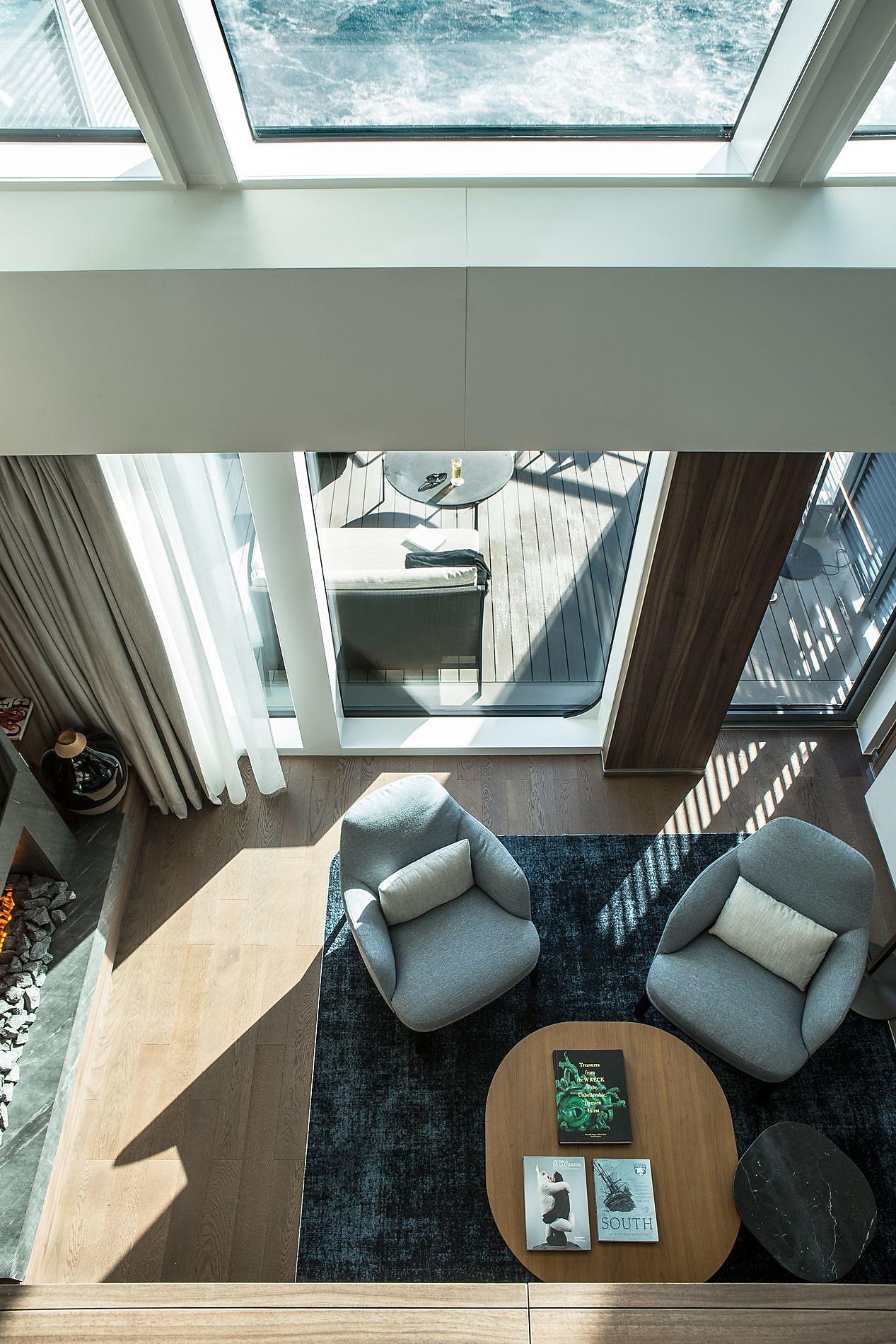
Benefits
- Openwork private balcony for 100% of our cabins and suites
- Terrace for the Duplex suites and the Shipowner’s suite
- 24 hour room service
- Unlimited Wi-Fi included (random satellite reception depending on navigation and latitude)
- Individual air conditioning
- Dressing room with shelves and wardrobe space
- Dressing table and hair dryer
- Dyptique Paris high-end products in large containers
- Mini bar included
- Nespresso coffee machine and kettle
- Electronic safe
- Satellite direct dial telephone
- Bose Bluetooth speaker
- Flat screen TV, international channels (random depending on your navigation) and videos on demand
- 110/220 volt installation
- Three PRM cabins
In addition to the common services provided to all our suites and staterooms:
- A private return transfer
- Priority boarding
- Champagne and fruit basket upon arrival
- Butler service
- An assortment of sweet or savory canapes and a fruit basket every day
- A living room with armchairs, convertible sofa, steam fireplace and TV
- A dining room with a table for 6 people
- A mini-bar cabinet equipped with RIEDEL crystal glassware
- A Samsung tablet connected to Wi-Fi
- A bedroom with king-size bed (180 x 200 cm) or two single beds (90 x 200 cm) and TV
- A bathroom with shower and spa bath
- Five panoramic glass windows and a panoramic glass hinged door
- A private terrace of 26 m²: outdoor lounge with sofa and armchairs, jacuzzi
- Two pairs of Swarvoski CL Companion 10 x 30 binoculars
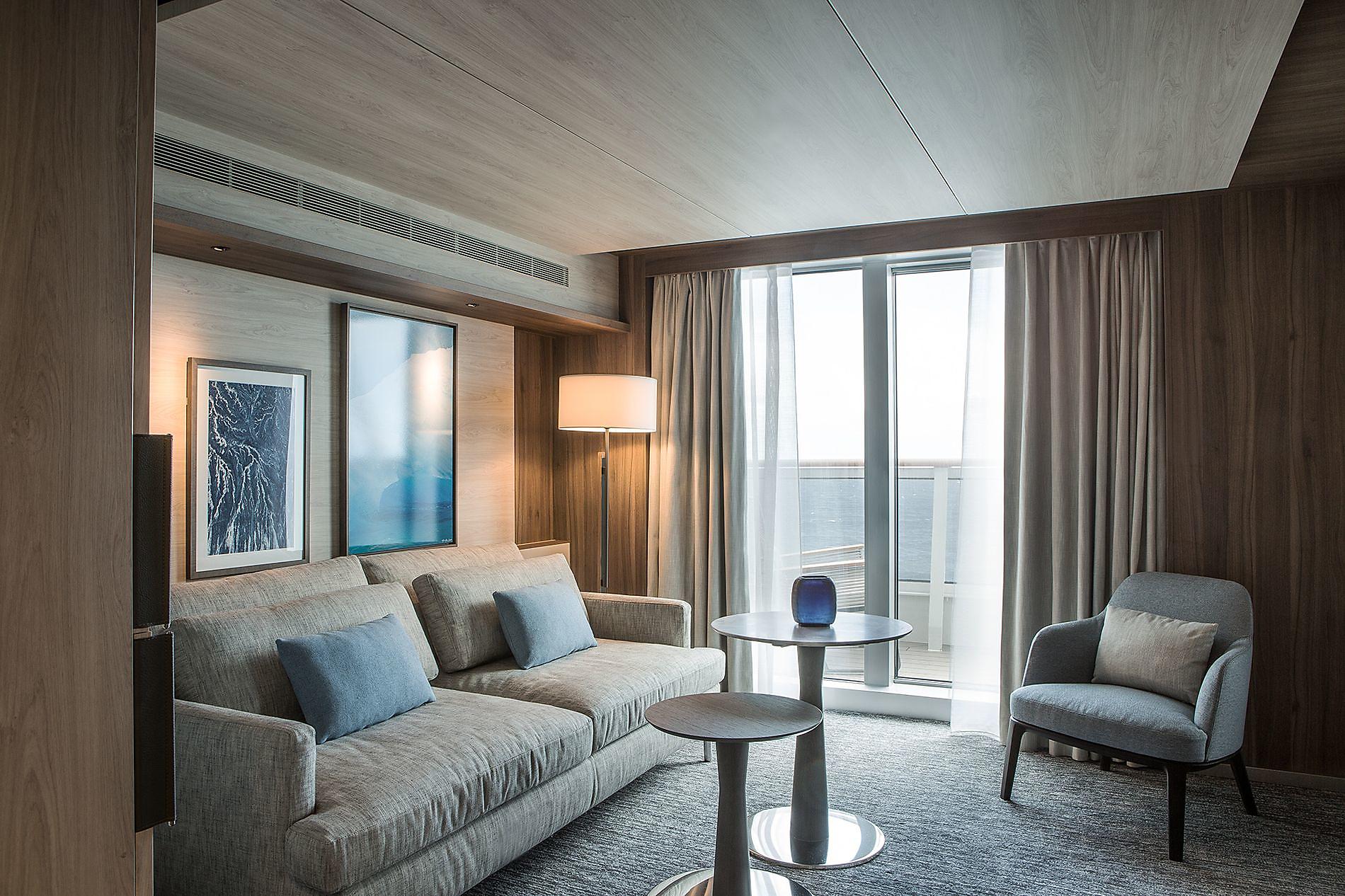
Benefits
- Openwork private balcony for 100% of our cabins and suites
- Terrace for the Duplex suites and the Shipowner’s suite
- 24 hour room service
- Unlimited Wi-Fi included (random satellite reception depending on navigation and latitude)
- Individual air conditioning
- Dressing room with shelves and wardrobe space
- Dressing table and hair dryer
- Dyptique Paris high-end products in large containers
- Mini bar included
- Nespresso coffee machine and kettle
- Electronic safe
- Satellite direct dial telephone
- Bose Bluetooth speaker
- Flat screen TV, international channels (random depending on your navigation) and videos on demand
- 110/220 volt installation
- Three PRM cabins
In addition to the common services provided to all our suites and staterooms:
- Priority boarding
- Champagne and fruit basket upon arrival
- Butler service
- An assortment of sweet or savory canapes and a fruit basket every day
- A living room with convertible sofa, armchair and sliding courtesy door
- A Samsung tablet connected to Wi-Fi
- A bedroom with king-size bed (180 x 200 cm) or two single beds (90 x 200 cm) and TV
- A bathroom with shower and spa bath
- Two panoramic sliding windows and a porthole
- A 12.5 m² open balcony
- Two pairs of Swarvoski CL Companion 10 x 30 binoculars
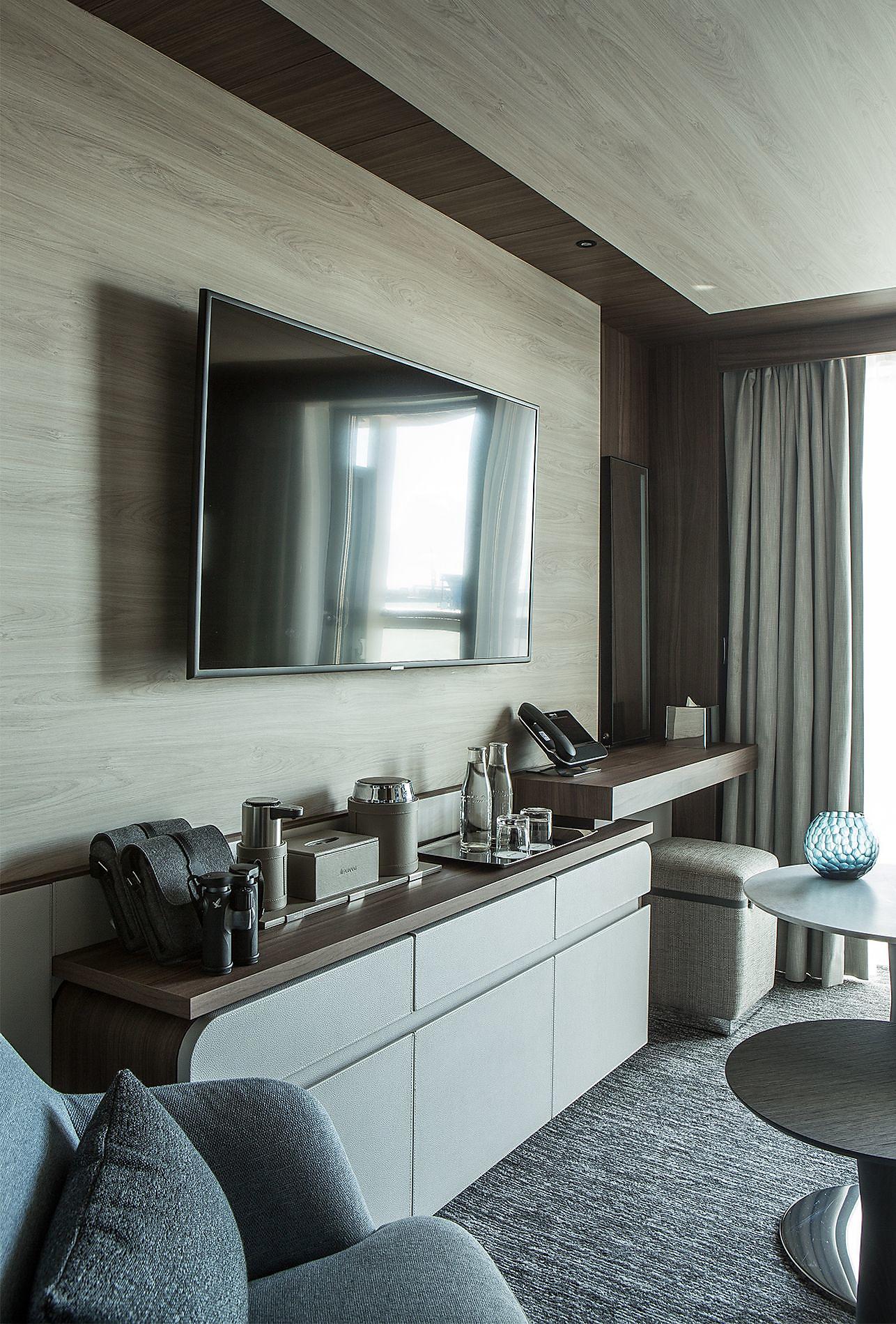
Benefits
- Openwork private balcony for 100% of our cabins and suites
- Terrace for the Duplex suites and the Shipowner’s suite
- 24 hour room service
- Unlimited Wi-Fi included (random satellite reception depending on navigation and latitude)
- Individual air conditioning
- Dressing room with shelves and wardrobe space
- Dressing table and hair dryer
- Dyptique Paris high-end products in large containers
- Mini bar included
- Nespresso coffee machine and kettle
- Electronic safe
- Satellite direct dial telephone
- Bose Bluetooth speaker
- Flat screen TV, international channels (random depending on your navigation) and videos on demand
- 110/220 volt installation
- Three PRM cabins
In addition to the common services provided to all our suites and staterooms:
- Priority boarding
- Champagne and fruit basket upon arrival
- Butler service
- An assortment of sweet or savory canapes and a fruit basket every day
- A lounge area with chaise longue and TV
- A Samsung tablet connected to Wi-Fi
- A king-size bed (180 x 200 cm) or two single beds (90 x 200 cm) and TV
- A bathroom with shower and spa bath
- A panoramic sliding bay window
- A 5 m² open balcony
- Two pairs of Swarvoski CL Companion 10 x 30 binoculars
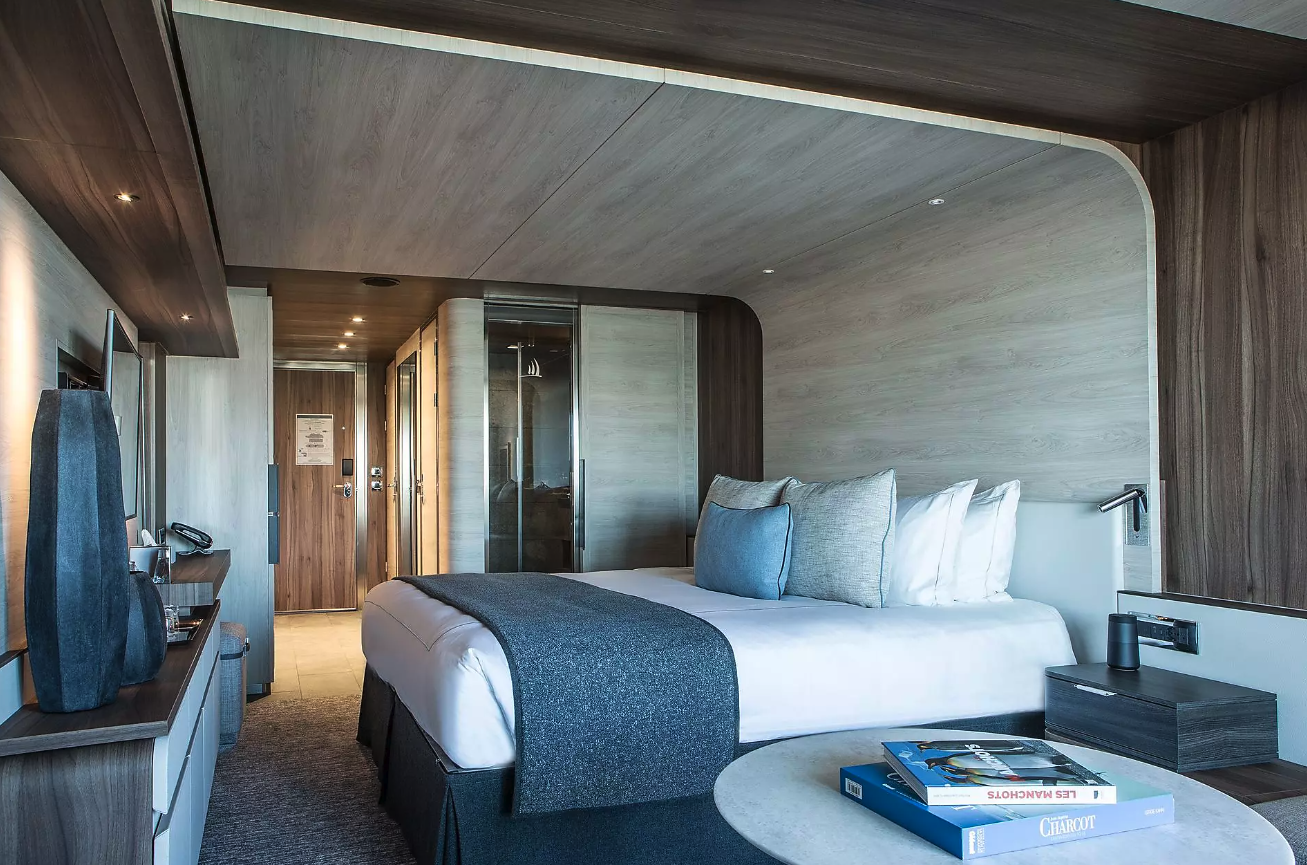
Benefits
- Openwork private balcony for 100% of our cabins and suites
- Terrace for the Duplex suites and the Shipowner’s suite
- 24 hour room service
- Unlimited Wi-Fi included (random satellite reception depending on navigation and latitude)
- Individual air conditioning
- Dressing room with shelves and wardrobe space
- Dressing table and hair dryer
- Dyptique Paris high-end products in large containers
- Mini bar included
- Nespresso coffee machine and kettle
- Electronic safe
- Satellite direct dial telephone
- Bose Bluetooth speaker
- Flat screen TV, international channels (random depending on your navigation) and videos on demand
- 110/220 volt installation
- Three PRM cabins
In addition to the common services provided to all our suites and staterooms:
- A lounge area with a chaise longue and two armchairs
- A king-size bed (180 x 200 cm) or two single beds (90 x 200 cm) and TV
- A bathroom with shower
- A panoramic sliding bay window
- A 5 m² open balcony
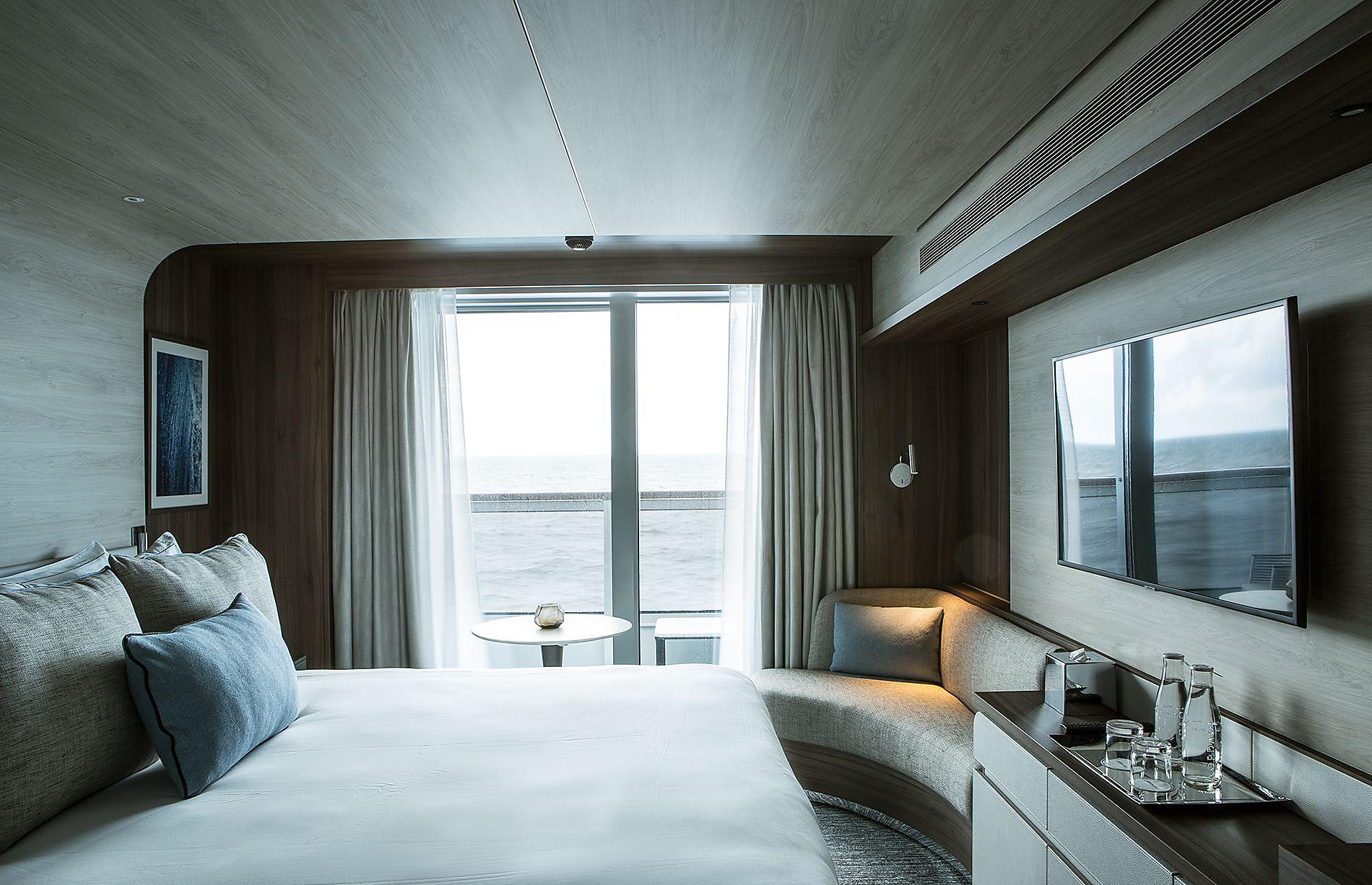
Benefits
- Openwork private balcony for 100% of our cabins and suites
- Terrace for the Duplex suites and the Shipowner’s suite
- 24 hour room service
- Unlimited Wi-Fi included (random satellite reception depending on navigation and latitude)
- Individual air conditioning
- Dressing room with shelves and wardrobe space
- Dressing table and hair dryer
- Dyptique Paris high-end products in large containers
- Mini bar included
- Nespresso coffee machine and kettle
- Electronic safe
- Satellite direct dial telephone
- Bose Bluetooth speaker
- Flat screen TV, international channels (random depending on your navigation) and videos on demand
- 110/220 volt installation
- Three PRM cabins
In addition to the common services provided to all our suites and staterooms:
- A king-size bed (180 x 200 cm) or two single beds (90 x 200 cm) and TV
- A bathroom with shower
- A panoramic sliding bay window
- A 5 m² glazed private balcony
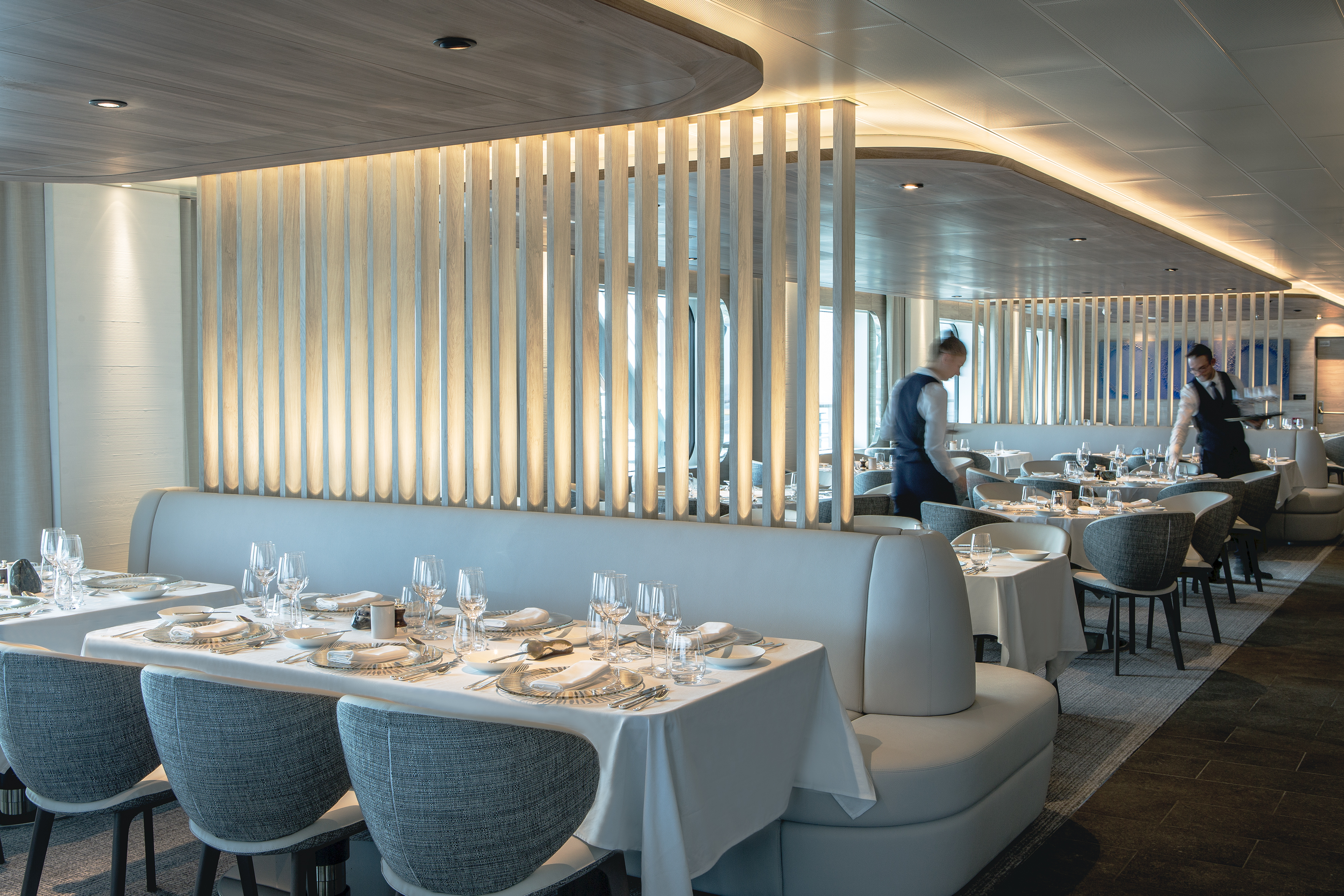
Nuna, the 484 m² gastronomic restaurant at the rear of deck 5, can seat all the ship’s passengers at a single sitting. Elegant and refinement are all part and parcel of the à la carte dining experience it has to offer at breakfast, lunch and dinner. The ship’s second bridge is located at the back of the restaurant: behind its large windows, you will have a front row seat to observe the crew during their operations.
- Capacity : 245
- French and international cuisine
- Signature dishes by Alain Ducasse
- Fine wine cellar
- Furniture by Ligne Roset
- Bernardaud French china and glassware by Elne
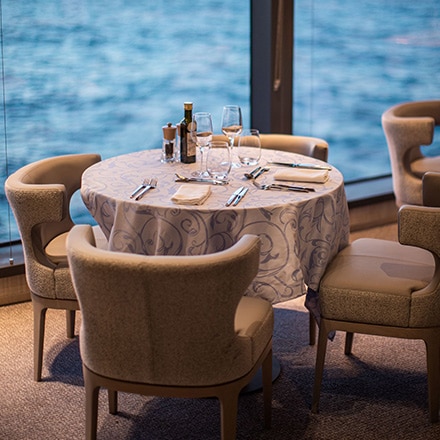
In a more relaxed atmosphere, a 320 m² restaurant located at deck 9 will welcome you for your breakfasts, buffet lunches and themed dinners.
- Indoor capacity: 142
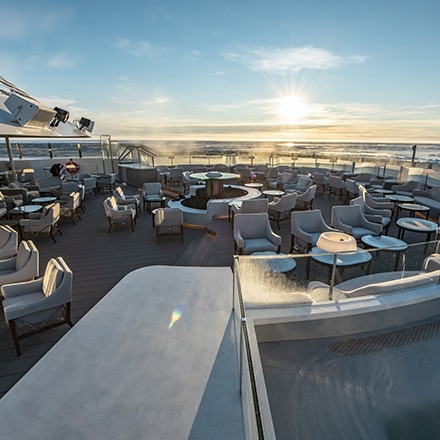
At the open-air bar, you can enjoy a varied and refined range of international sweet and savoury dishes throughout the day (11am-6pm), as well as a permanent menu.
- Bar capacity : 79
- Restaurant capacity : 62

Whether you wish to have breakfast in the privacy of your stateroom, savour a snack in the middle of the day or enjoy your dinner in an intimate setting, our Room Service is available for you. Have a gourmet interlude and treat yourself from a varied menu at any time of day or night *.
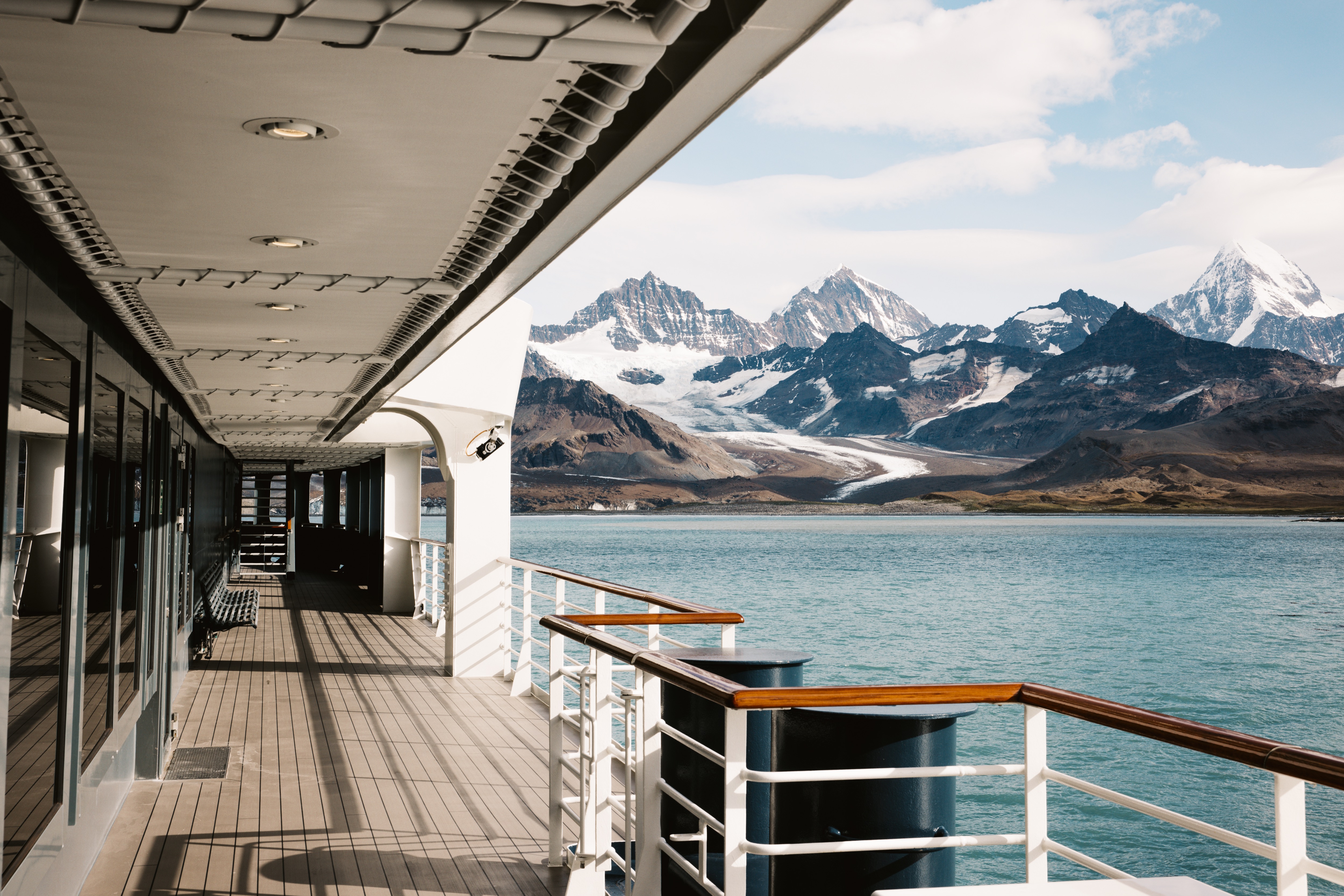
Excursions & land itineraries
Each itinerary has been thoughtfully created by our teams to offer you a complete excursion experience. You can discover the hidden gems of the regions you visit in line with your interests.
Hidden creeks, ancient cities, UNESCO world heritage sites… the world reveals its hidden gems as you journey along the routes taken by travellers. In keeping with our ethos “Accessing the worlds treasures by sea”, we offer a wide choice of land excursions during all our cruises (except for expeditions). Chosen by our PONANT experts for their cultural value and historic interest, these excursions can last a few hours or a few days. If you need to stay on land overnight, we take care of your stay from start to finish, until you rejoin your ship. These longer excursions mean you can discover the unmissable sites of the region you are visiting, like Cuzco in Peru for example or the Mekong Delta in Vietnam.
You can access these trips by pre-booking two months before your departure date.
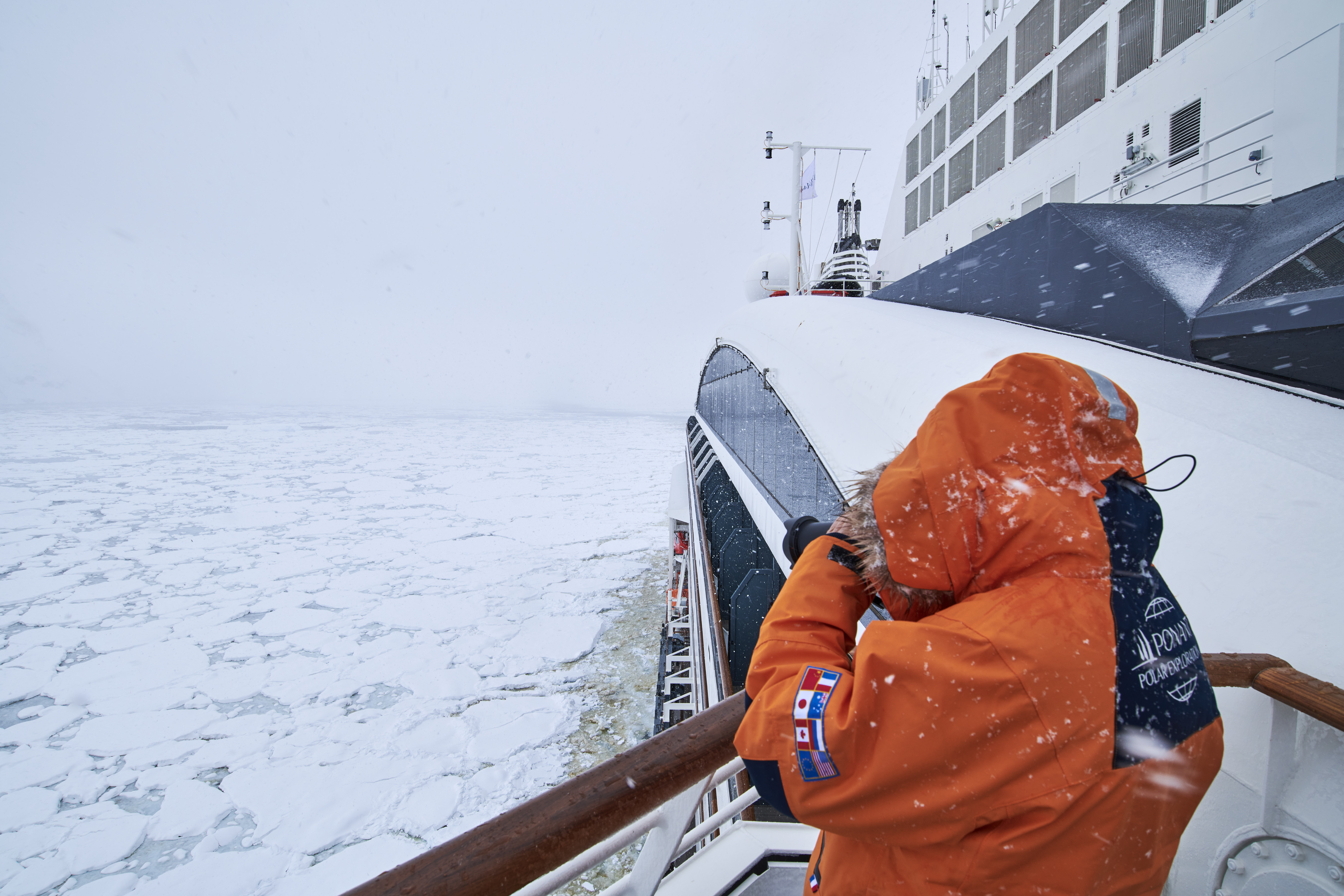
This first ever deep polar navigation cruise ship opens the gateways to the highest latitudes of the Arctic and the Antarctic. Embark for a faraway odyssey combining exploration with science, and become experts in these regions that for centuries have stirred the imaginations of the greatest adventurers. See this captivating and wondrous part of the world for yourself.
An On-Hand Expedition Team By Your Side
Le Commandant Charcot expedition team constitutes one of the best guest-to-staff ratios found on any voyage of this kind. Biologists, naturalists, engineers, glaciologists, and geologists, these experts in the polar regions will be on hand to ensure the safety of all your activities and experiences and to share their passion for the poles. They will be by your side throughout your voyage of discovery, providing key insights to help you get the most out of the encounters with fauna, flora and local populations that await you, and helping you better understand the stakes and challenges involved in preserving this natural and cultural heritage
Expedition leaders
Alongside the captain, the expedition leader is the main person responsible for managing and coordinating the exploration aspect of the cruise. They supervise the team of naturalist guides and scientific mediators, ensure the safety of the organised activities offered, and tailor and adapt the experiences, thus ensuring the full richness of these fascinating ecosystems is revealed in all its glory.
Naturalist guides
A team of 23 naturalist guides trained in supervising activities in polar environments will be by your side every day to interpret and explain everything about these largely unexplored ecosystems, both onboard the ship and during onshore activities. Meet some of the members of the team.
Science Mediators
The scientific mediation team on Le Commandant Charcot brings science to life for guests onboard the ship. Their mission is to give you an insight into the profession of scientific researcher and the challenges involved in the scientific approaches deployed, and enable you to contribute directly to the study and protection of the polar regions by giving you the opportunity to take part in citizen science workshops.
The poles like never before
Le Commandant Charcot takes you further than ever before, sailing well inside the polar circles and deep into the middle of the ice, where only a PC2 polar class ship (icebreaker) can safely venture. Onboard, on land, on the sea or on the ice, enjoy a range of unique, intense and authentically immersive experiences amidst the quasi-hypnotic power of the polar environment, such as dog sledding, sightseeing excursions in Zodiac® inflatable boats, snowshoeing, polar diving, kayaking, ice fishing and citizen science sessions.
A scientific research and monitoring vessel
Sailing through the remote and icy regions of the poles provides a unique opportunity to regularly and periodically collect scientific data for use in understanding how sea ice forms, analysing ocean circulation, studying the biological characteristics of the polar marine environment, tracking and monitoring marine megafauna, and analysing the social and environmental impacts of tourism. The data collected by researchers and passengers through citizen science sessions is helping to advance research into these regions – which more than a century after the heroic golden age of polar exploration still have much to reveal – and move forward efforts to protect and preserve them.

-
Two dedicated expedition boarding and disembarking rooms to port and starboard.
- A conference room (Ilua – to be inside, to understand) : 30 seats
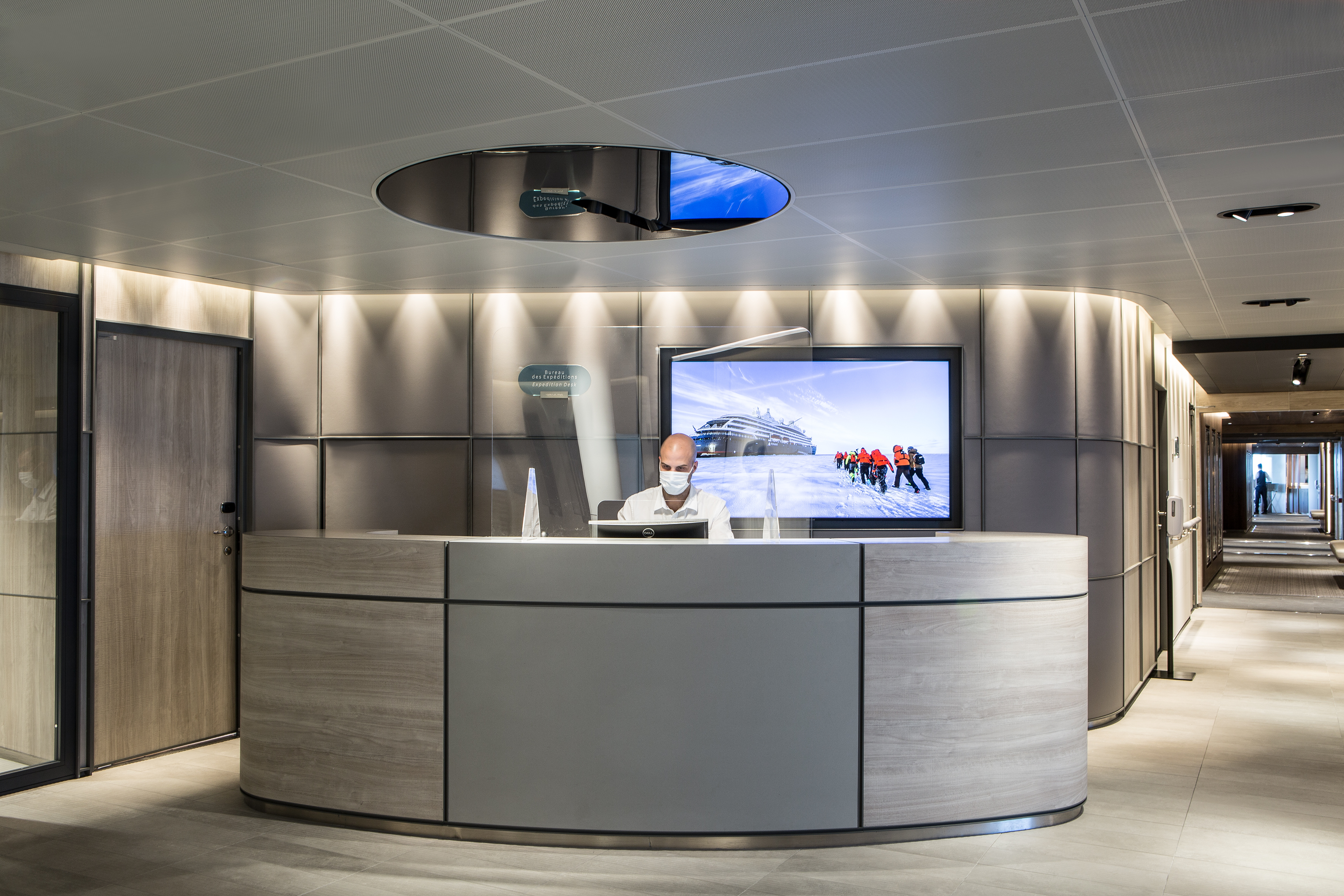
The Expedition Desk is located on Deck 5.

- A bar and a 262 m² observatory lounge
- Library, reading corner, “live” entertainment on certain evenings
- 2 Swarovski Optik spotting scopes

- A main living room of 313 m²
- A 24 m² “smoking” area
- A tea room area and a bar with “live” musical programming on certain evenings
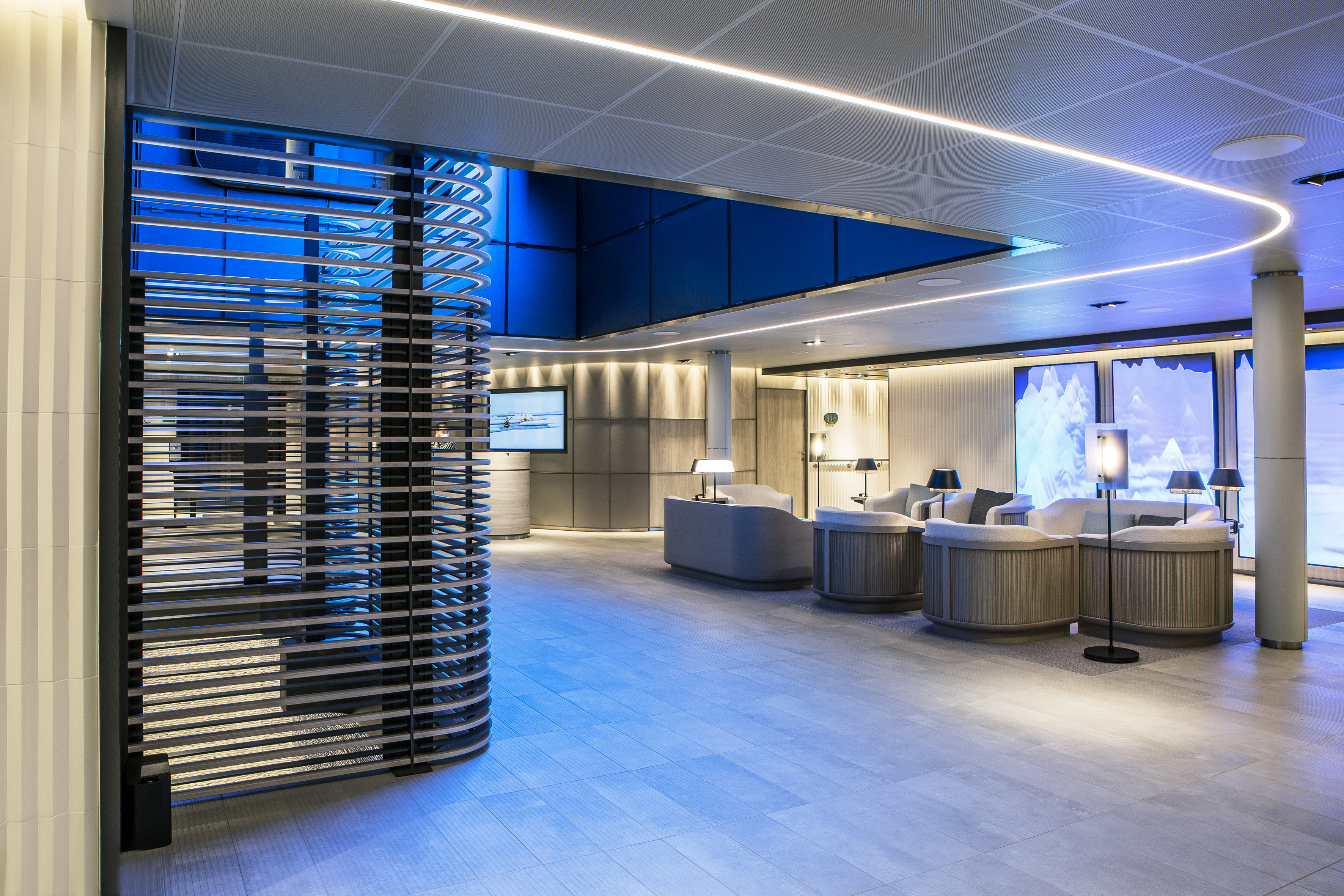
- A reception area of 270 m²
- The shipping office
- Administrative services on board
- The sales office run by our Reception and Travel Manager
- “Ponant Studio” photo space
- “Oscillations”: a digital work of art by Miguel Chevalier
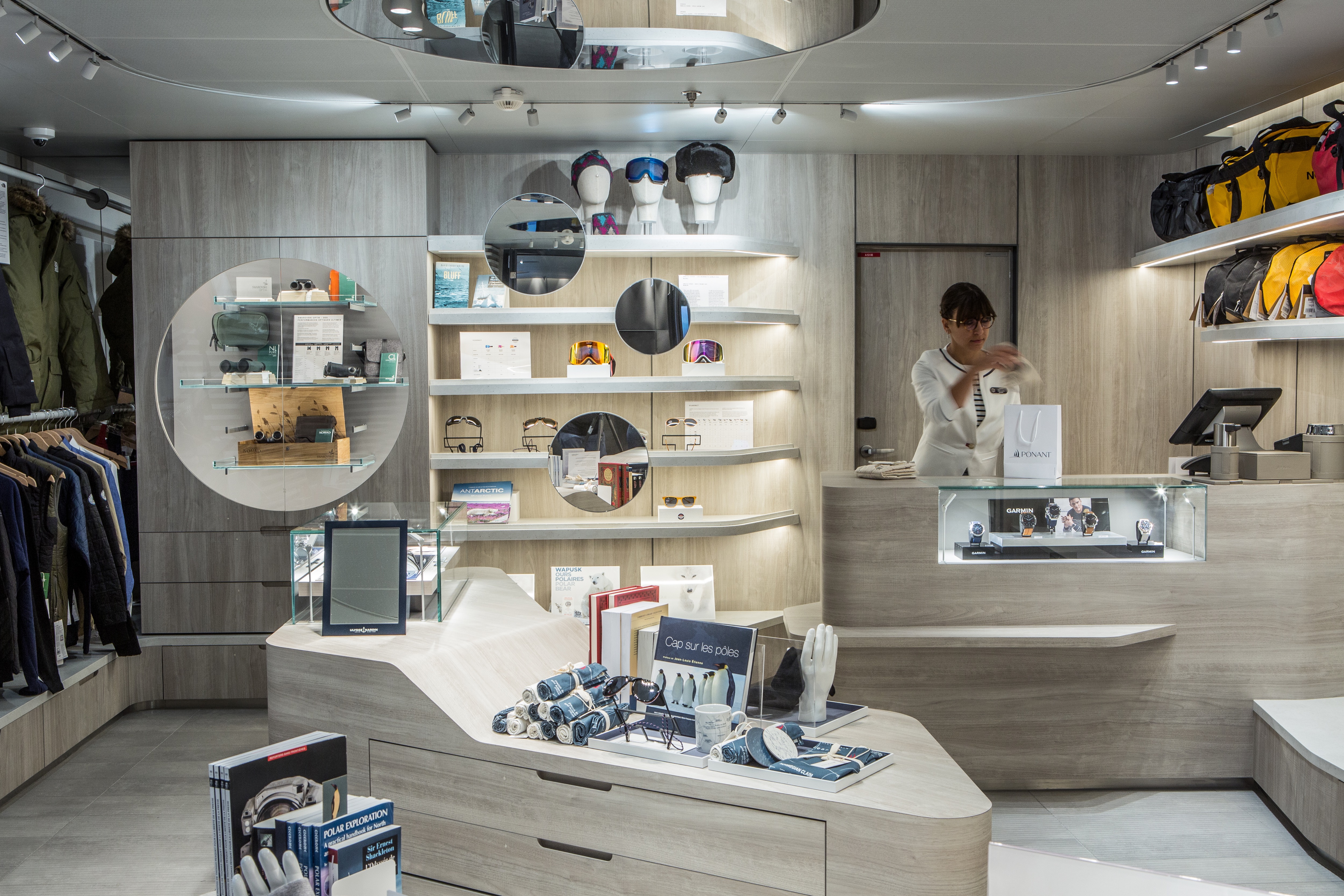
An extension of the voyage and the ship, the Illu boutique is a space dedicated to discovering the polar world. 95% of the souvenir range is made in France, and our partners offer textiles that respect the environment.

- The Blue Lagoon baths, outdoor lagoon heated from 27 to 37° C thanks to energy recovery
- A giant brazier ( Inneq – the fire) allowing you to enjoy the polar landscapes in complete comfort
- An outdoor bar (Blue Lagoon bar) to enjoy throughout the day (11 a.m. to 6 p.m.) a varied and refined sweet and savory food offer.
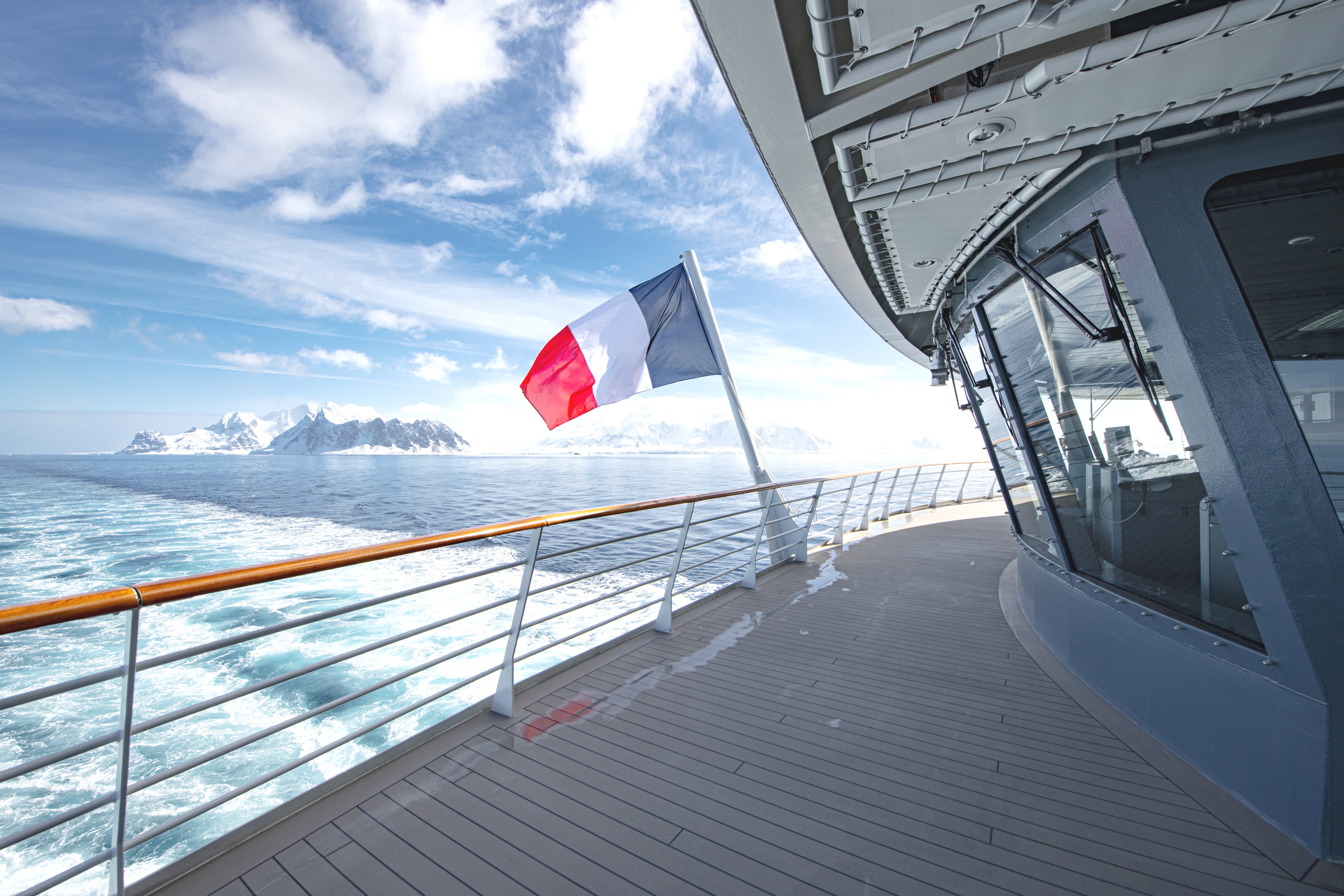
The exterior promenade deck is uninterrupted. This makes it possible to circle the ship completely and get to the bow, unlike the majority of passenger ships.
It is also equipped with benches heated using energy recovery and, at the rear, two Swarovski Optik spotting scopes.

- Capacity of 270 people
- State-of-the-art sound and light technologies
- LED wall at the back of the stage allowing the projection of supports in very high resolution

A photography and videography team escort you throughout your trip. These professionals capture the most beautiful moments of your cruise, which you can share with family and friends upon your return. Meet them on DECK 5 (DECK 6 on the PONANT Explorers ships) at the photo/video area, where you can also order souvenir pictures and videos.
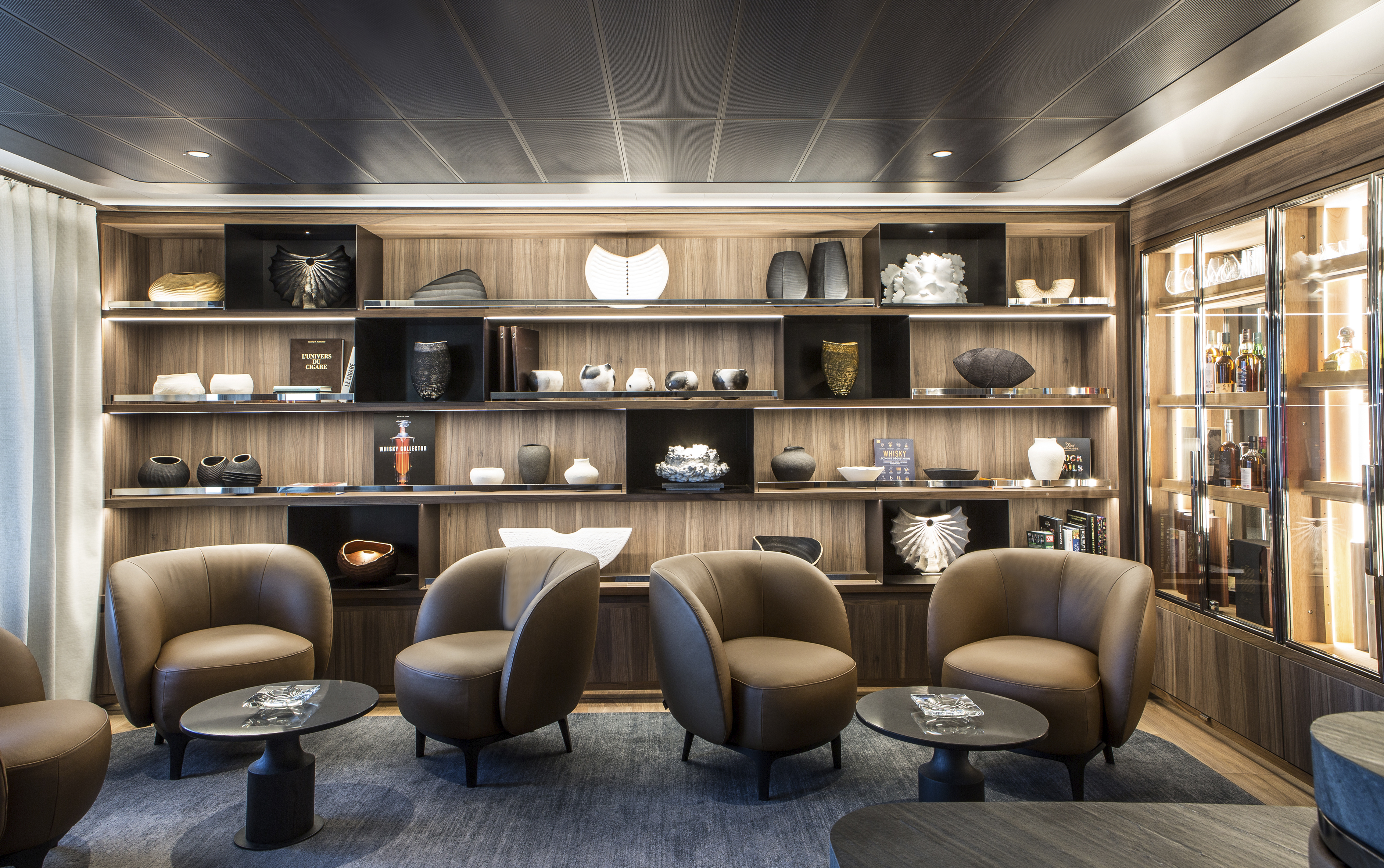
The Cigar Lounge is located on Deck 5.
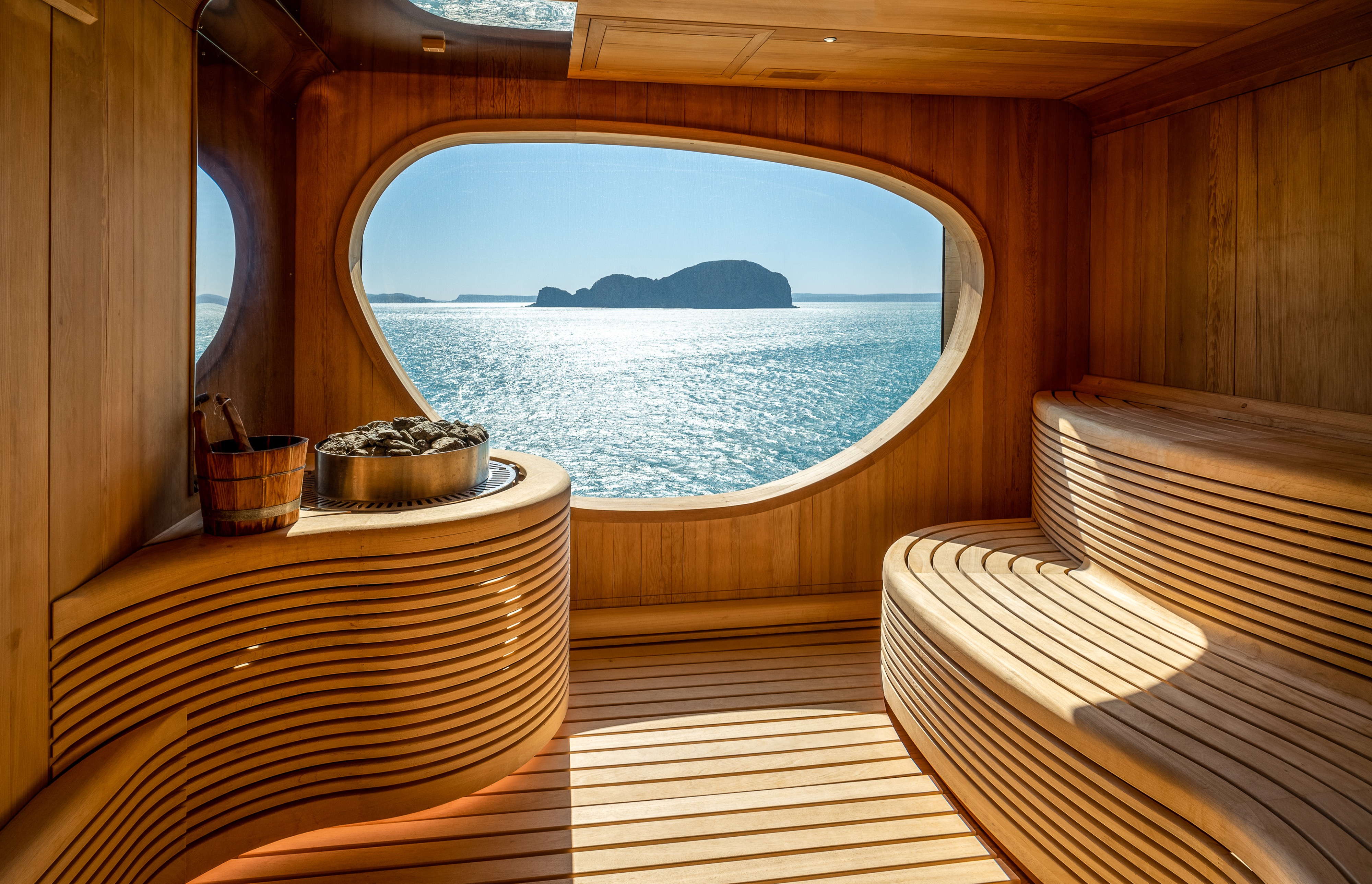
All our ships feature an onboard spa. Equipped with massage cabins and a Turkish bath (Sisterships) or a sauna (Explorers), the spa offers a wide choice of top-of-the-range treatments provided in association with SOTHYS™ or CLARINS (Le Bellot and Le Jacques-Cartier only), leading French spa and wellness centre brands.
Discover a range of facial treatments, aromatic baths, exfoliation and body massage treatments designed to provide moments of complete relaxation. You can also supplement your beauty ritual with additional services such as hair-removal, makeovers, manicures and pedicures.
Prices and details of services in the PONANT Yacht Spa menu.
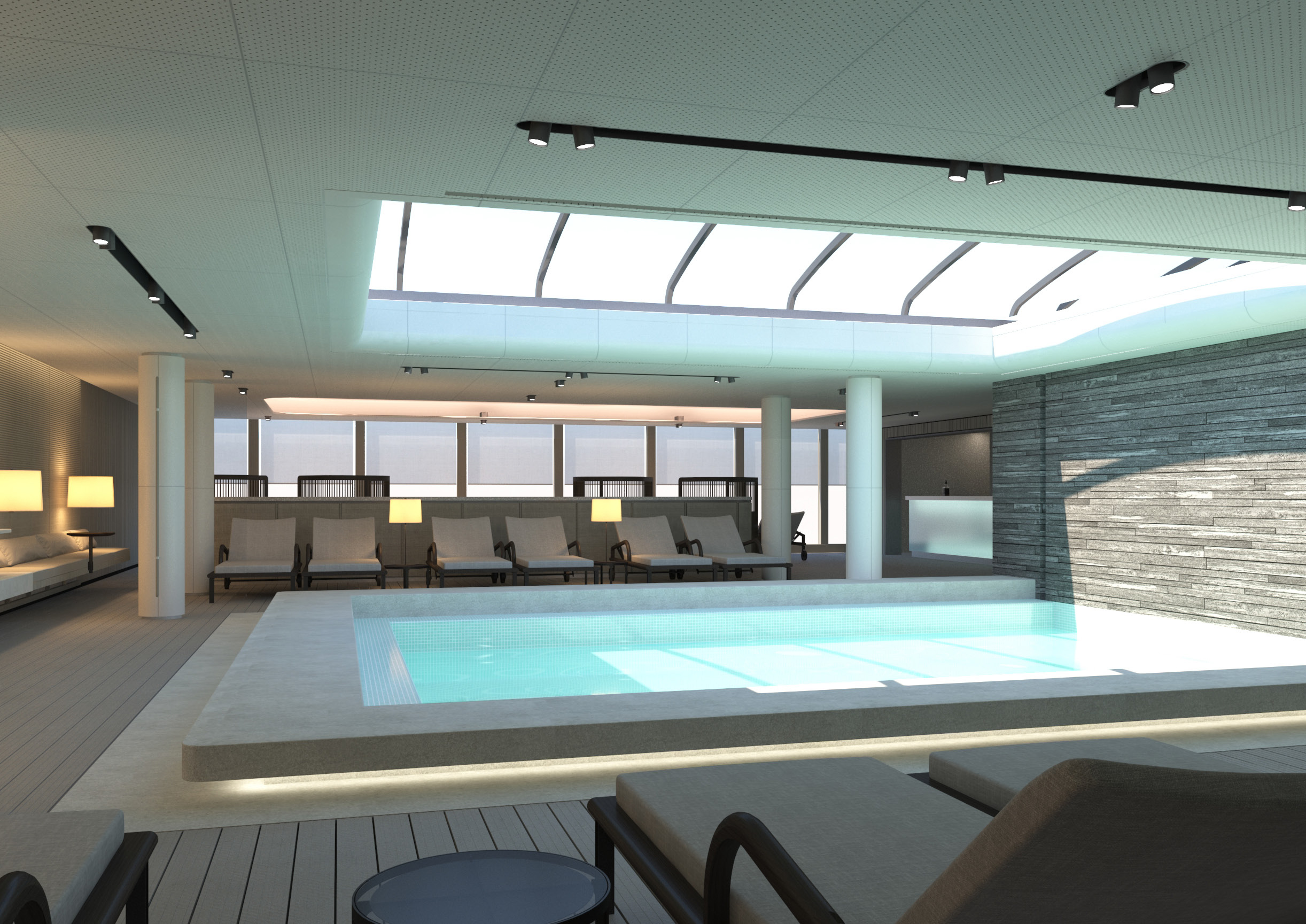
A hair salon facing the boundless horizon, massage cabins with large windows, a sauna with an unobstructed view of the immense white polar expanse… The wellness areas on board Le Commandant Charcot take on a new dimension. These spaces, designed by Jean-Michel Wilmotte, combine design and comfort, and have been created with expert know-how using repsonsible brands.

The gyms on our ships are equipped with the very latest Technogym© equipment and machines. Treadmills, exercise bikes, Kinesis Wall© strength training machines and many other types of equipment are all provided in a laid-back relaxing environment. The wide floor-to-ceiling windows looking out over the sea add undeniable charm to the exercise sessions.
Each day also begins with organised morning workout sessions, either out in the open air or in the theatre. These are supplemented by water aerobics in the pool, or in the sea off the beach for PONANT passengers, when the situation allows it.

Provided in partnership with KÉRASTASE® and L’ORÉAL PROFESSIONNEL®, the hairdressing salon offers a complete range of top quality treatments designed to strengthen, nourish and reinvigorate hair’s shine and brilliance. Our stylists are available to serve all your styling, highlighting, colouring, cutting and tailored hair advice needs.
Your stateroom Officer will be able to take care of your laundry**. The washing and ironing of your clothes will take between 24 and 48 hours. Only ironing** can be delivered on the same day. As dry-cleaning is not possible on the ship, please only give us clothes that can be washed in water.
** These services are not free of charge and are billed directly to your stateroom account.
Closed spaces such as the lounges, the dining room, the staterooms and the reception are non-smoking areas. We invite you to smoke in designated outdoor parts of the ship.
Adapters are provided on board, they are available at the reception office of our ships.
European Standard Sockets
The 220 volt 50 hertz alternating current is distributed by sockets meeting European standards. Onboard power is 200 volt AC (European standard) and 110 volt AC (North American standard). For safety reasons, hair irons and clothes irons cannot be used in staterooms. Please note that on Le Ponant, 110 volt AC is only available in stateroom bathrooms.
Children under one year of age shall not be authorised to embark on the ships.
For children aged between 1 and 8 years old, an authorisation to board the ship must be made in writing to PONANT. Subject to agreement, a liability waiver must be completed and returned to the company to validate the registration.
On classic cruises (“yachting”), children are accepted from the age of one, with a maximum of 5 children between 1 and 6 years old on board.
On “expedition” cruises children are accepted from 6 years old (except cruises aboard Le Commandant Charcot) and must be fully independent during all the outside activities organised and during disembarkation in rubber boats, be sufficiently tall to sit on the inflatable sides of the boats, and old enough to understand, and immediately respond to the orders given by the persons in charge. As a result, children’s participation in any activity in an inflatable boat shall be subject to the agreement of the Captain and of the Expedition Head, depending on the sea conditions, and the difficulty of disembarking at each location visited. The ships do not carry Parka’s in children’s sizes. Parents must arrange to bring a suitable Parka for children. In all cases, children and young people under the age of 18 are at all times on board or on land under the full and total responsibility of their parents or carers.
For all “expedition” cruises on board Le Commandant Charcot, children are accepted from 8 years old only.
Children aged 4 years or more can be welcomed in the Kid’s Club when the service is offered on board
The crew are bilingual in French and English. All signage and announcements made are in French and English. On certain cruises, crew members also speak other languages.
A satellite telephone system is at your disposal for contacting anyone, anywhere in the world. The cost of the call is added to the stateroom account (€6/minute). Calls that you receive can be transferred directly to your stateroom or to any other communal area on the ship. To receive or send faxes, please see Reception.
Free Wi-Fi internet access is available on all of our ships, in both the staterooms and the communal areas. One or several computers are at your disposal in the recreation centres. Please note that the Wi-Fi connection may be discontinued depending on the navigation area and landscapes that may block the vessel from satellite coverage, especially at high latitudes (no connection possible beyond 80° North or South), or for technical reasons beyond our control.
There is a doctor on board available to the passengers on all our ships:
- The schedules of consultation are listed each day in the log book (emergency consultation 24/7).
- The Sisterships, PONANT Explorers and Le Commandant Charcot also have a hospital for any small surgery.
- During the excursions, the passengers are accompanied by a doctor or a nurse.
- There is a fee for consultations on board . The price may vary according to the time and place of the consultation (hospital or staterooms). You must also pay for medications.
- The doctor on board is not authorised to distribute sick leaves and prescriptions. Only accounts and invoices are provided which may be used by the passenger to obtain a refund from his/her health insurance if his/her contract allows.
Medical Consultations
There is a charge for medical consultations undertaken by the doctor or nurse on board. The price can vary according to the time and place of the consultation (hospital or stateroom). Any medication must also be paid for by the passenger. If using medications on a regular basis make sure to bring adequate supplies for the duration of your cruise.
Special Medical Treatment
If you have any special treatment, we ask you to inform the reservation service when you register for the cruise, to note it on the information sheet before departure, then inform the on-board crew at the moment of departure and always keep your medication with you for the duration of the cruise.
Seasickness
Our ships (except Le Ponant) have stabilisers equipped with dynamic fins which adapt to the movements of the ship. This system allows the ship to anticipate and compensate for the pitching and tossing of the sea to achieve greater stability. Passengers suffering from seasickness will see their symptoms alleviated and are pleasantly surprised to not feel uncomfortable during their journey. However it is wise to bring travel motion medication with you for peace of mind.
Our Sisterships, PONANT EXPLORERS and Le Commandant Charcot were designed for people with reduced mobility in mind:
- Specially designed staterooms;
- Access ramps allowing easy movement in communal areas;
- Posters, signage and stateroom numbers are translated into Braille.
Despite these arrangements, each passenger should be able to be independent or travel with a close family member or friend who can give them whatever assistance they require during their trip.
If a person has not been judged suitably fit for travel in complete safety, the company reserves the right to refuse their embarkation. Disembarkation in difficult places or in a Zodiac® is subject to the approval of the Captain, who will always have the safety and wellbeing of the passenger in mind.
Technical Accessories
We advise you to equip yourself with a ski mask, sunglasses, walking poles (available to purchase in the shop), a waterproof rucksack, binoculars, a technical watch, a mosquito head net (for the Arctic) and a waterproof pouch.
We advise our passengers to wear casual and elegant outfits at their convenience, and more formal attire for the Captain’s Dinner.
Sustainable development is enshrined in the company’s articles of association and has been at the heart of the PONANT project since its inception. Founded over thirty years ago by committed sailors, the company was born out of a desire to share a passion for the oceans and the treasures of the Earth. This responsibility commits us to a respectful dialogue with the environment and the populations we meet and to investing in many fields related to the preservation and development of the natural and cultural heritage of the polar and oceanic regions.
Clean Ships
We were among the first cruise operators in the world to abandon the use of heavy fuels, and our ships are equipped with electric diesel engines and SCR catalytic converters, which enable a reduction in fuel consumption and emissions. Our polar exploration ship, Le Commandant Charcot, is a hybrid-electric vessel, propelled by liquefied natural gas (LNG). LNG enables a 25% reduction in carbon emissions, an 85% reduction in nitrogen oxide emissions and a 95% reduction in fine particle emissions. Each time we design a new ship, we equip it with the latest available eco-technologies, enabling us to maintain our position as the cruise industry’s environmental leader, ahead of international regulations in some areas. A commitment recognised by many independent organisations:
- Our entire fleet is Clean Ship certified by the Bureau Veritas. This certification guarantees that our ships fulfil very precise criteria: emissions levels, waste processing, waste water etc.
- In 2020, PONANT was recognised as “the cruise operator with the greenest fleet in the world in terms of airborne emissions” by the German NGO, NABU.
- PONANT was awarded the Prix des Palmes du Tourisme Durable 2020 (Prize for Sustainable Tourism) in the “Voyage” category for the elimination of heavy fuel oil in favour of LS MGO.
- In 2019, PONANT became the first European cruise company to obtain the North American Green Alliance certificate. This certifies that its members have adopted practices and technologies that are respectful towards the environment.
- PONANT is also a signatory of the Charte Bleue from Armateurs de France, which commits the maritime sector to act to protect the marine environment.
Wastewater
All of the wastewater is treated by means of processes that exclude the use of chemical products. The recycled water is used to clean the exterior of the ship. The water that is discharged into the sea is treated, drinkable water.
Waste
We have optimised our organisation in order to reduce waste at the source. Waste is nonetheless still produced on board. As of 2020, 60% of this is sorted and recycled, with an objective of 85% set for 2023. We ensure the complete traceability of this waste.
Single-use plastics
We have eliminated the use of single-use plastics (straws, cups, food serving trays, laundry bags etc.). A metallic flask is issued to each passenger on expedition cruises and water fountains are available in the common areas of the ships. We are also developing the bottling of our water in glass bottles.
- Inneq Bar
- Blue Lagoon
- Sila Restaurant
- Indoor Pool
- Winter Garden and Detox Bar
- Fitness
- Spa
- Nail Bar
- Snow Room
- Panoramic Lounge
- Sauna
- Bridge
- Staterooms
- Accessible Staterooms
- Staterooms
- Training Centre
- Staterooms
- Accessible Staterooms
- Promenade Deck
- Nuna Gastronomic
- Restaurant
- Aft, Bridge
- Photo Video
- Reception Desk
- Expeditions Desk
- Shop
- Cigar Lounge
- Sales Cruise Desk
- Main Lounge
- Theatre
- Bar
- Expedition Room
- Conference Room

